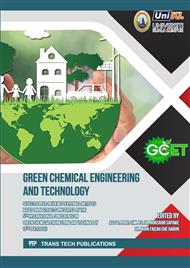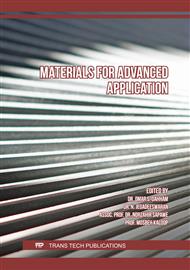[1]
V. Forti, C.P. Balde, R. Kuehr, G. Bel, The Global E-waste Monitor 2020: Quantities, flows and the circular economy potential. United Nations University (UNU)/United Nations Institute for Training and Research (UNITAR) – co-hosted SCYCLE Programme, International Telecommunication Union (ITU) & International Solid Waste Association (ISWA), Bonn/Geneva/Rotterdam, (2020).
Google Scholar
[2]
F. Yang, S. Jin, Y. Xu, Y. Lu, Comparisons of IL-8, ROS and p.53 responses in human lung epithelial cells exposed to two extracts of PM2.5 collected from an e-waste recycling area, China, Environ. Res. Lett. 6 (2011) 024013.
DOI: 10.1088/1748-9326/6/2/024013
Google Scholar
[3]
T.S. Lebbie, O.D. Moyebi, K.A. Asante, J. Fobil, M.N. Brune-Drisse, W.A. Suk, P.D. Sly, J. Gorman, D.O. Carpenter, E-Watse in Africa: A serious threat to the health of children, Int. J. Environ. Res. Public Health. 18 (2021) 8488.
DOI: 10.3390/ijerph18168488
Google Scholar
[4]
Y. Lu, Z. Xu, Precious metals recovery from waste printed circuit boards: A review for current status and perspective, " Resour. Conserv. Recycl. 113 (2016) 28–39.
DOI: 10.1016/j.resconrec.2016.05.007
Google Scholar
[5]
F. Cucchiella, I. D'Adamo, S. C. Lenny Koh, P. Rosa, Recycling of WEEEs: An economic assessment of present and future e-waste streams, Renew. Sustain. Energy Rev. 51 (2015) 263-72.
DOI: 10.1016/j.rser.2015.06.010
Google Scholar
[6]
B. Ghosh, M. K. Ghosh, P. Parhi, P. S. Mukherjee, B. K. Mishra. Waste printed circuit boards recycling: An extensive assessment of current status." J. Clean. Prod. 94 (2015) 5-19.
DOI: 10.1016/j.jclepro.2015.02.024
Google Scholar
[7]
A. Akcil, C. Erust, C.S. ekha. Gahan, M. Ozgun, M. Sahin, and A. Tuncuk, Precious metal recovery from waste printed circuit boards using cyanide and non-cyanide iixiviants – A review, Waste Manag. 45 (2015) 258-71.
DOI: 10.1016/j.wasman.2015.01.017
Google Scholar
[8]
I.M.S.K. Ilankoon, Y. Ghorbani, M.N Chong, G. Herath, T. Moyo, J. Petersen, E-waste in the international context – A review of trade flows, regulations, hazards, waste management strategies and technologies for value recovery, Waste Manag. 82 (2018) 258-75.
DOI: 10.1016/j.wasman.2018.10.018
Google Scholar
[9]
A. Sepúlveda, M. Schluep, F.G. Renaud, M. Streicher, R. Kuehr, C. Hagelüken, A.C. Gerecke, A review of the environmental fate and effects of hazardous substances released from electrical and electronic equipments during recycling: Examples from China and India, Environ. Impact Assess. Rev. 30 (2010) 28-41.
DOI: 10.1016/j.eiar.2009.04.001
Google Scholar
[10]
J. Cui, L. Zhang, Metallurgical recovery of metals from electronic waste: A review, J. Hazard. Mater. 158 (2008) 228-56.
Google Scholar
[11]
A. Habibi, S.S Kourdestani, M. Hadadi, Biohydrometallurgy as an environmentally friendly approach in metals recovery from electrical waste: A review, Waste Manag. Res. 38 (2020) 232-44.
DOI: 10.1177/0734242x19895321
Google Scholar
[12]
D. Qi, Treatment of wastewater, off-gas, and waste solid, in: Hydrometallurgy of Rare Earths, Elsevier, 2018, p.743–77.
DOI: 10.1016/b978-0-12-813920-2.00008-8
Google Scholar
[13]
E. Karwowska, D. Andrzejewska-Morzuch, M. Łebkowska, A. Tabernacka, M. Wojtkowska, A. Telepko, A. Konarzewska, Bioleaching of metals from printed circuit boards supported with surfactant-producing bacteria, J. Hazard. Mater. 264 (2014) 203-10.
DOI: 10.1016/j.jhazmat.2013.11.018
Google Scholar
[14]
M. Arshadi, S. M. Mousavi, Multi-objective optimization of heavy metals bioleaching from discarded mobile phone PCBs: Simultaneous Cu and Ni recovery using Acidithiobacillus ferrooxidans, Sep. Purif. Technol. 147 (2015) 210-19.
DOI: 10.1016/j.seppur.2015.04.020
Google Scholar
[15]
J.K. Pradhan, S. Kumar, Metals bioleaching from electronic waste by Chromobacterium violaceum and Pseudomonads sp., Waste Manag. Res. J. a Sustain. Circ. Econ. 30 (2012) 1151-59.
DOI: 10.1177/0734242x12437565
Google Scholar
[16]
S. Ilyas, M.A. Anwar, S.B. Niazi, M.A. Ghauri, Bioleaching of metals from electronic scrap by moderately thermophilic acidophilic bacteria, Hydrometallurgy, 88 (2007) 180-88.
DOI: 10.1016/j.hydromet.2007.04.007
Google Scholar
[17]
I. Wiegand, K. Hilpert, R.E.W. Hancock, Agar and broth dilution methods to determine the minimal inhibitory concentration (MIC) of antimicrobial substances, Nat. Protoc. 3 (2008) 163-175.
DOI: 10.1038/nprot.2007.521
Google Scholar
[18]
J.C. Ribeiro Junior, T. Ronaldo, F.S. Bruna, A. M. de Oliveira, F.D.G. Silva, F.F. da Silva, N.A. Augusto, V. Beloti, Efficiency of boiling and four other methods for genomic DNA extraction of deteriorating spore-forming bacteria from milk, Semin. Ciências Agrárias, 37 (2016) 3069.
DOI: 10.5433/1679-0359.2016v37n5p3069
Google Scholar
[19]
C. Dallenne, A. Da Costa, D. Decré, C. Favier, G. Arlet, Development of a set of multiplex PCR assays for the detection of genes encoding important β-lactamases in Enterobacteriaceae, J. Antimicrob. Chemother. 65 (2010) 490-95.
DOI: 10.1093/jac/dkp498
Google Scholar
[20]
E. Y. L. Sum, The recovery of metals from electronic scrap, JOM. 43 (1991) 53-61.
DOI: 10.1007/bf03220549
Google Scholar
[21]
D. Das, S. Mukherjee, M. G. Chaudhuri, Studies on leaching characteristics of electronic waste for metal recovery using inorganic and organic acids and base, Waste Manag. Res. J. a Sustain. Circ. Econ. 39 (2021) 242-49.
DOI: 10.1177/0734242x20931929
Google Scholar
[22]
P. Sandrasaigaran, P. Rajandrai, M. W. Loon, H. Hasan, Isolation and characterization of Chromobacterium sp. from lake water at Manipal International University, Malaysian J. Med. Heal. Sci. 17 (2021) 154-161.
Google Scholar
[23]
M. Arshadi, S.M. Mousavi, P. Rasoulnia, Enhancement of simultaneous gold and copper recovery from discarded mobile phone PCBs using Bacillus megaterium: RSM based optimization of effective factors and evaluation of their interactions, Waste Manag. 57 (2016) 158-167.
DOI: 10.1016/j.wasman.2016.05.012
Google Scholar
[24]
A. Kumar, H.S. Saini, S. Kumar, Enhancement of gold and silver recovery from discarded computer printed circuit boards by Pseudomonas balearica SAE1 using response surface methodology (RSM), 3 Biotech. 8 (2018) 100.
DOI: 10.1007/s13205-018-1129-y
Google Scholar
[25]
J.H. Batista J.F.d.S. Neto, Chromobacterium violaceum pathogenicity: Updates and insights from genome sequencing of novel Chromobacterium species, Front. Microbiol. 8 (2017) 1-7.
DOI: 10.3389/fmicb.2017.02213
Google Scholar
[26]
S. Sharmin, A.A. Jahan, S.M.M. Kamal, P. Sarker, Case report fatal infection caused by Chromobacterium violaceum : A case report from a tertiary care hospital in Bangladesh, (2019) 1–4.
DOI: 10.1155/2019/6219295
Google Scholar
[27]
M. Okada, R. Inokuchi, K. Shinohara, A. Matsumoto, Y. Ono, M. Narita, T. Ishida, C. Kazuki, S. Nakajima, N. Yahagi, Chromobacterium Haemolyticum-induced bacteremia in a healthy young man, BMC Infect. Dis. 13 (2013) 406.
DOI: 10.1186/1471-2334-13-406
Google Scholar
[28]
W.E. Farrar, N.M. O'Dell, β-Lactamase activity in Chromobacterium violaceum, J. Infect. Dis. 134 (1976) 290-93.
Google Scholar
[29]
T. Miki, M. Iguchi, K. Akiba, M. Hosono, T. Sobue, H. Danbara, N. Okada, Chromobacterium pathogenicity island 1 type III secretion system is a major virulence determinant for Chromobacterium violaceum induced cell death in hepatocytes, Mol. Microbiol. 7 (2010) 855-72.
DOI: 10.1111/j.1365-2958.2010.07248.x
Google Scholar
[30]
D. Rawat, D. Nair, Extended-spectrum ß-lactamases in gram negative bacteria, J. Glob. Infect. Dis. 2 (2010) 263.
DOI: 10.4103/0974-777x.68531
Google Scholar
[31]
C.A. Hart, Pocket guide to extended-spectrum β-lactamases in resistance," J. Antimicrob. Chemother. 58 (2006) 231.
Google Scholar
[32]
CLSI, M100 Performance Standards for Antimicrobial Susceptibility Testing A CLSI supplement for global application,, (2020).
Google Scholar
[33]
D.L. Paterson, Resistance in Gram-negative bacteria: Enterobacteriaceae, Am. J. Med. 119 (2006) S20-S28.
DOI: 10.1016/j.amjmed.2006.03.013
Google Scholar
[34]
A.M. Queenan, B. Foleno, C. Gownley, E. Wira, K. Bush, Effects of inoculum and β-Lactamase activity in AmpC and extended-spectrum β-Lactamase (ESBL) producing Escherichia coli and Klebsiella pneumoniae clinical isolates tested by using NCCLS ESBL methodology, J. Clin. Microbiol. 42 (2004) 269-275.
DOI: 10.1128/jcm.42.1.269-275.2004
Google Scholar
[35]
L.B. Rice, S.H. Willey, G.A. Papanicolaou, A.A. Medeiros, G.M. Eliopoulos, R.C. Moellering, G.A. Jacoby, Outbreak of ceftazidime resistance caused by extended-spectrum Beta-lactamases at a Massachusetts chronic-care facility. Antimicrob. Agents Chemother. 34 (1990) 2193-99.
DOI: 10.1128/aac.34.11.2193
Google Scholar
[36]
G.M. Rossolini, M.M.D'Andrea, C. Mugnaioli, The spread of CTX-M-type extended-spectrum β-lactamases, Clin. Microbiol. Infect. 14 (2008) SUPPL. 1, 33–41.
DOI: 10.1111/j.1469-0691.2007.01867.x
Google Scholar
[37]
W.-H. Zhao and Z.-Q. Hu, Epidemiology and genetics of CTX-M extended-spectrum β-lactamases in Gram-negative bacteria, Crit. Rev. Microbiol. 39 (2013) 79–101.
DOI: 10.3109/1040841x.2012.691460
Google Scholar
[38]
S. ur Rahman, T. Ali, I. Ali, N.A. Khan, B. Han, J. Gao, The growing genetic and functional diversity of extended spectrum Beta-lactamases, Biomed Res. Int. 2018 (2018) 1–14.
DOI: 10.1155/2018/9519718
Google Scholar



